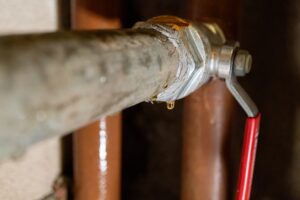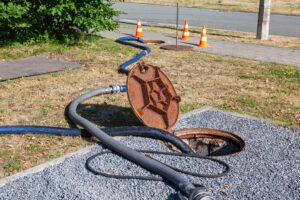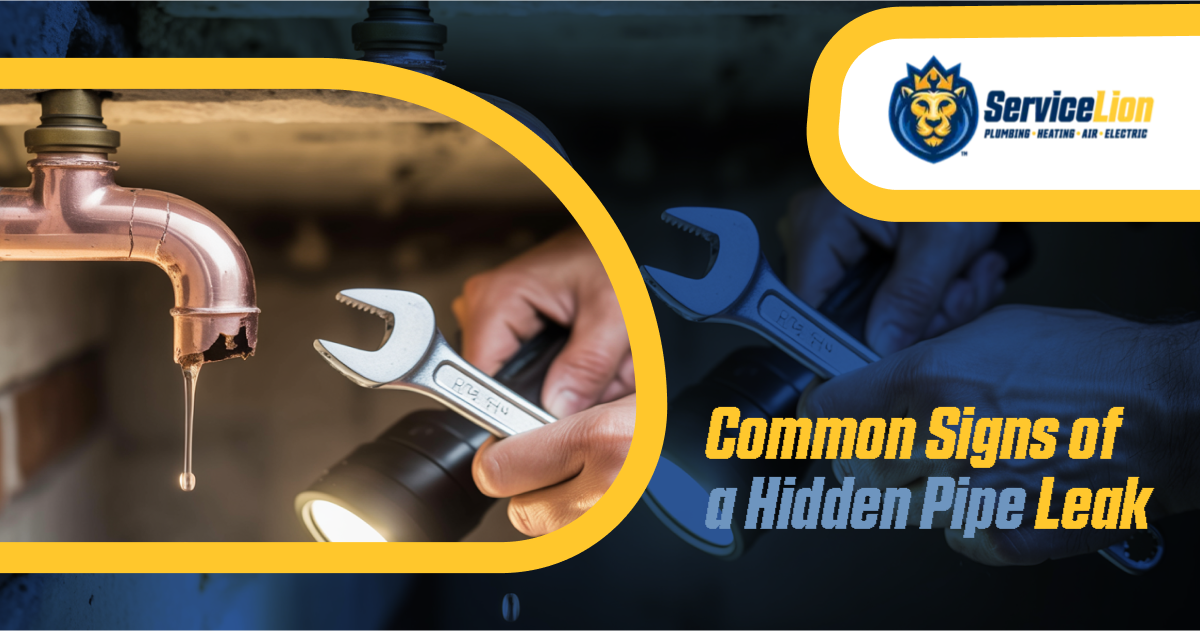Essential Insights
- Hidden leaks can occur in walls, floors, ceilings, or underground.
- Look for hidden leak pipe signs like musty odors, soft floors, bubbling paint, and higher water bills.
- Plumbing leak detection methods allow professionals to find leaks without opening walls.
- Quick action limits structural damage, mold, and costly repairs.
Why Hidden Pipe Leaks Are a Serious Problem
Hidden pipe leaks can covertly cause significant and widespread problems throughout your home before they’re obvious. When they’re concealed behind walls, under floors, or in ceilings, leaks often go unnoticed until the damage is advanced and costly to repair. These are some of the problems you may face if you have a hidden pipe leak in your home:
- Water damage: Leaking water can cause discoloration, bubbling paint, warping, and other permanent damage.
- Mold: Moisture in enclosed areas provides ideal conditions for mold to develop, which can spread quickly through drywall and insulation. Spores can create or exacerbate allergies, asthma, and other respiratory or overall health problems, and mold remediation is often costly.
- Electrical hazards: If leaking water contacts electrical wiring or outlets inside walls, it increases the risk of electrical shorts, shocks, or even electrical fires.
- Structural damage: Leaks can compromise the structural integrity of framing, foundations, and other components.
How Can I Tell If I Have a Hidden Water Leak?

Since most plumbing lines are behind walls or under concrete, spotting the warning signs of hidden water leaks requires careful observation.
Unexplained water bill spikes
A sudden increase in your monthly water bill is often the first indicator of a hidden leak. When your household habits haven’t changed but your water meter and bills show high usage, water is likely escaping somewhere in the system.
Musty odors or mold growth
Persistent dampness creates an ideal environment for mold and mildew. If you notice a persistent musty or earthy smell in rooms without visible water damage signs, there may be a leak behind walls or beneath flooring. Check your home thoroughly for visible mold, which appears as patches or specks of green, black, or white.
Peeling or bubbling walls
Moisture trapped behind walls weakens paint and drywall. Bubbling, blistering, or peeling surfaces are often found near leaking plumbing lines in bathrooms, kitchens, and laundry rooms.
Water damage on walls and ceilings
Discoloration or stains on drywall and ceilings may appear as circular rings, streaks, or shadowy patches with faint yellow or brown outlines. These patches of damage can appear far from the source of the leak, and they may worsen with the use of specific fixtures or appliances.
Soft or spongy flooring
Flooring typically softens as it absorbs moisture. If sections of your flooring feel soft, spongy, or uneven, there may be a leak in the subfloor. Wooden floors may warp, while laminate or vinyl tiles may lift or separate.
Reduced water pressure
A noticeable drop in water pressure at faucets or showers may signal that water is escaping before it reaches the fixture.
What Causes Hidden Plumbing Leaks?
Hidden leaks can stem from several underlying issues that affect different parts of your plumbing system. Potential causes of hidden plumbing leaks include:
- Corrosion: Older metal pipes are susceptible to corrosion, particularly in areas with hard water, which weakens pipe walls until small pinhole leaks form.
- Environmental factors: Shifting soil and heavy rainfall can erode areas around pipes and cause them to sag, increasing the risk of misalignment and breaks throughout your yard or beneath your foundation.
- Poor installation: Improper pipe fittings, inadequate sealing, or poorly joined connections often lead to premature failure.
- High water pressure: Constantly high water pressure strains joints and connections, eventually causing leaks. Installing a pressure regulator helps maintain balanced flow.
- Aging materials: Pipes, seals, and valves deteriorate with age. Galvanized steel, polybutylene, and older copper pipes are especially prone to failure.
- Tree roots: Roots may invade underground water lines in search of moisture. Once inside, they expand, obstruct water flow, and create cracks that allow water to escape.
- Blockages: Caused by debris, cooking grease, or mineral scale, blockages trap and increase pressure within pipes and may cause cracks and breaks.
Why You Shouldn’t Ignore the Signs of a Hidden Leak
Early action keeps damage contained and minimizes repair costs. If you suspect a hidden leak, follow these steps:
- Step one: Turn off the main water supply to stop the flow. If you can isolate a fixture or branch, close that valve and test for relief.
- Step two: Check for electrical hazards, like water near devices, wires, or outlets, and disconnect power from your electrical panel if necessary.
- Step three: Remove belongings from the area and dry the space as much as possible. Remove standing water with a mop or towels.
- Step four: Use fans and dehumidifiers to dry out the area.
- Step five: Call a professional plumber from Service Lion to stabilize and fix leaks efficiently.

How Plumbers Detect Hidden Pipe Leaks Without Tearing Into Walls
Professional plumbers use specialized tools and methods to detect hidden pipe leaks in ceilings, floors, and walls. Rather than demolishing parts of your home, plumbers narrow down potential leak locations by looking for visual clues, such as discolored ceilings or warped flooring.
Plumbers also use noninvasive technology to pinpoint the exact source of the leak. Acoustic leak detection equipment identifies the sound of escaping water, even through concrete or drywall, and thermal imaging cameras detect temperature differences resulting from moisture. Moisture meters and hygrometers further confirm excess moisture behind walls, under floors, or in ceilings. Finally, specialized plumbing camera inspections involve feeding a high-resolution camera through cleanouts to inspect drains and visually confirm hidden leaks and their causes.
Service Lion: Trusted Leak Detection & Plumbing Repair in Brea, CA
Service Lion provides expert plumbing leak detection and repair throughout Brea and neighboring communities. We identify leaks behind walls, under slabs, and within ceilings without unnecessary demolition. Our plumbers are licensed, insured, and experts in leak detection and repair. Customers enjoy these benefits when they schedule leak repairs with Service Lion:
- Upfront and affordable pricing
- Flexible financing options
- Same-day service
- 100% guaranteed satisfaction
Service Areas in Orange County, CA
Service Lion proudly serves homeowners throughout Orange County, including:
- 92821 – Brea
- 92865 – Orange
- 92870 – Placentia
- 92807 – Anaheim Hills
Stop Hidden Pipe Leaks Before They Become Costly Repairs
Detecting and repairing hidden leaks early protects your property from damage and keeps your plumbing system flowing as it should. If you notice signs of water leaks in walls, ceilings, or floors, contact us at Service Lion for professional plumbing leak detection and repair.
Frequently Asked Questions
What are the signs of a leak behind walls or under floors?
You may notice musty odors, bubbling paint, soft floors, or water stains from hidden leaks spreading on walls or ceilings. These changes often mean water is seeping from a pipe hidden within your home’s structure.
What are the signs of a slab leak under my home?
Warm or damp spots on concrete floors, higher water bills, and unexplained mold growth are common indicators of slab leaks. You may also hear water running even when fixtures are off.
Why do hidden leaks cause water stains on walls or ceilings?
Water seeps into porous materials like drywall and plaster, leaving minerals behind as it dries. These mineral deposits create the dark or yellowish stains seen on ceilings and walls.


